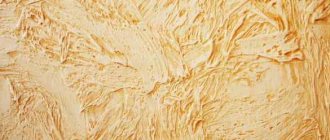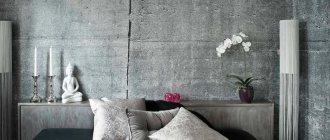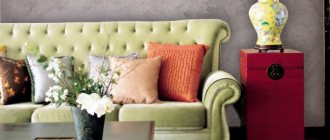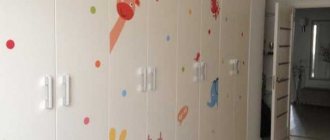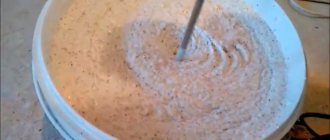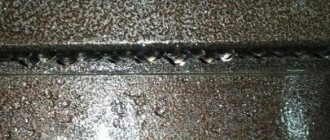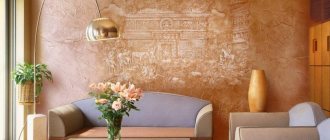A kitchen should simultaneously combine elegance, functionality, and practicality. Only in this case will users feel as comfortable as possible while indoors. Achieving the designated combination of room characteristics can be difficult. It will require the use of high-quality modern finishing materials and remarkable patience. Decorative plaster, which has unique features and gives the room aesthetic appeal, will come to the rescue in decorating the kitchen space.
Kitchen design tips
When choosing an option for finishing walls, an apron or a dining area in the kitchen, you must give preference to practical, environmentally friendly and aesthetic coatings.
Decorative plaster fully meets these requirements. The composition includes natural materials and is suitable for use in the kitchen. Application methods allow you to create imitation of various surfaces. Properties that indicate the practicality of using decorative plaster in the kitchen:
- Moisture resistance.
- Fire resistance.
- Antibacterial properties
- Abrasion resistance.
- No seams.
Advantages and disadvantages
Like any finishing material, decorative plaster has its pros and cons. Should I use it in the kitchen? Let's try to figure this out.
Carefully study the features of the material.
Important: The disadvantages of decorative plaster most often depend on its type.
The undeniable advantages of decorative plaster include :
- Decorative plaster can be applied to all types of coatings: concrete, wood, iron.
- Thanks to the characteristics of the material, you get a seamless coating. An ideal choice for spacious kitchens where wide walls need to be finished.
- There is no need to carefully level the coating before applying decorative plaster: the light relief even adds charm to the finish.
- The material allows air to pass through easily, allowing the walls to breathe.
- The walls can be vacuumed and washed, which is very important in the kitchen.
- Mineral impurities prevent the development of fungus and mold.
- This is a very wear-resistant and durable material.
- Ease of repair. Even if a fragment of the wall is damaged, it is not necessary to restore the entire surface - it is enough to replace the deformed part.
Take into account the characteristics of the material so as not to encounter unpleasant surprises.
The disadvantages can be considered :
- If the building is still in the process of shrinkage, cracks may appear in the mineral decorative plaster. They are easy to seal, but we still consider this property a disadvantage.
- Plaster is expensive. In addition, you will have to pay a lot for finishing work - not all builders have yet learned how to work professionally with the material.
- If you choose mineral plaster, be prepared for the fact that after application it will have to be painted - the material is produced only in white.
- Acrylic type of decorative plaster cannot be used over slabs - it can release toxic impurities.
- To apply silicate plaster, it is necessary to first apply a special primer. In addition, it requires special care in application.
- This also applies to the silicone type. In addition, it is considered the most expensive, if you do not take into account exclusive design options.
Decorative plaster can be an excellent material if you take into account all the nuances.
However, despite a fairly wide list of disadvantages, decorative plaster is considered one of the most popular coatings for the kitchen. Durable, reliable and beautiful - it will suit a room decorated in any interior style.
What types of decorative plaster can be used in the kitchen?
Depending on the composition, decorative plasters may have certain performance characteristics and appearance. The mixtures are based on mineral or synthetic material. And as additives to impart surface relief, stone chips, cellulose fibers or polymer granules are used.
Decorative coatings are also distinguished by the method of application. Venetian, textured and structural plaster is used in the kitchen.
Venetian
Marble finishing, made on the basis of plaster mixtures, is quite practical and economical compared to natural stone. Venetian plaster consists of stone dust, a binder, a dye and allows you to play with color and relief.
The photo shows a wall with Venetian marble finish.
The combination of glossy and matte veins, as well as pearlescent coating creates the effect of a natural material.
Textured
This type of finishing is achieved not through insoluble inclusions, but using a certain application technology and special spatulas. The result is a voluminous, relief surface with a unique pattern.
Textured plaster can include craquelure, or an artificially aged coating with cracks. It is achieved by alternating coatings of paint and craquelure varnish, which cracks when dry.
The photo shows the textured finish of the apron with the effect of scratches and potholes.
Structural
A decorative coating that has a granular structure due to the inclusion of insoluble granules or special fibers in the material is called structural. This surface will have a special texture.
The photo shows a structural granular coating for a kitchen work area.
Consumption varies depending on composition
Of course, textured decorative compositions are more difficult to apply, but such a coating looks more impressive. Typically, layer thickness and consumption vary with the size of the crumb.
| Type of decorative plaster for the kitchen | Consumption, release form |
| Textured (embossed like wood, bark beetle, stone) | 0.9 (grain 1 mm) - 1.5 (grain 3-4 mm) kg/sq. m |
| With quartz chips | 2 - 3 kg/sq. m. Powder for solution 25 kg. |
| Based on acrylic resin dispersion (with crumbs) | 2.5 kg/sq. m (grain 1 mm); 3 kg/sq. m (particle 2 mm). Sold ready-made. |
| Based on synthetic acrylic resins | 1.5 kg/sq. m (fraction 0.7-1 mm); 2 kg/sq. m (1.2-1.6 mm); 2.5 kg/sq. m (2-2.5 mm). Sold raw. |
| With marble chips (sand texture) | Apply a layer of 1-3 mm. Consumption from 1 kg/sq.m. Sold in 10 kg bags. |
| Bark beetle | 2.4 - 4 kg/sq. m depending on the size of the filler. The exact calculation depends on the specific brand. |
| Venetian (natural marble) | 70-200 gsm m. The number of layers depends on the desired color saturation. But a perfectly prepared surface is required + only a professional can apply it correctly. In the end, the most expensive. |
It should also be remembered that each type of decorative plaster requires impregnation of the surface with specific primers. Their choice depends on the type of base.
Kitchen Interior Design Ideas
The variety of structures and shades allows you to bring any design technique to life.
Under concrete
A decorative coating with a concrete effect can be made using special compounds, such as microcement, decorative art concrete or regular cement mortar. There is a wide selection of gray, beige, white, and sometimes rusty shades.
The photo shows a concrete wall in a modern interior.
Marble
Marbled plaster can be smooth or streaked. The color palette allows you to create a resemblance to natural stone.
Silk
Plaster with glossy or metallic pigment creates the effect of wet silk in the kitchen interior.
In the photo, the walls and apron in the kitchen-dining room are decorated using a “silk” effect.
Under the brick
Plaster with coarse fractions and a mineral base allows for volumetric finishing to look like brick.
In the photo, the apron is decorated to look like brick.
Colored
Decorating with different shades will help create a scuffed effect on the wall or a two-color pattern.
Advantages and disadvantages of plastering
There are many advantages to using decorative putty in the kitchen interior, but there are also disadvantages.
Interesting! The disadvantages arise from the type of mixture, each has its own.
| Advantages | Flaws |
| Apply to different types of surfaces (iron, wood, concrete). | The mineral type of putty may develop cracks if the building being repaired does not settle. But the cracks are simply sealed. |
| After all the operations, there are no seams left and the result is a spacious room, not divided into segments. | It costs a lot (especially silicone), and if you are not a professional you will need a lot of it. |
| There is no need to carefully level the walls before plastering. It will all level out on its own, and for the Venetian, a small relief is even welcome. | Mineral putty can only be painted in a snow-white shade. |
| The composition allows the walls to “breathe” due to the free movement of air. | Acrylic putty should not be applied over slabs because toxic substances may be released. |
| If the recipe contains minerals, then they do not allow mold, bacteria and fungi to multiply. | Before using the silicate type, it is necessary to prime the walls with a special solution using a complex technique. |
| Long service life and strong resistance to various negative influences. | |
| Ease of restoration. If a small part is damaged, there is no need to putty the entire surface again. |
Despite the large number of disadvantages, there are many more advantages. An additional advantage is its relevance in different designs, which is why it is in demand in kitchen decoration.
Colors of decorative plaster
There is a wide palette of decorative coating colors. Shades can be mixed or sprayed on top of each other, and also combined with decorative painting.
Most common colors:
- White.
- Grey.
- Beige.
- Brown.
- Green.
- Silver.
- Gold.
The photo shows a kitchen with a gray concrete finish.
Colors can be combined and applied randomly with strokes.
Peculiarities of work - expert advice
To ensure that working with decorative solutions does not seem very complicated, you need to take into account some nuances:
- It is necessary to prepare the walls as best as possible for puttying. A smooth finish will not work on very textured walls. And some textured putties will also not fit as they should.
- Plastering is more expensive than wallpapering or painting. Therefore, take this into account when planning your renovation. Always be prepared that you may need a new portion.
- Textured designs and deep reliefs require more material compared to smooth surfaces. This also needs to be taken into account when planning repairs. For example, acrylic type is required for 1 sq.m. on average from 2.5 kg. up to 3kg. But each manufacturer has different recommendations, you need to rely on the instructions.
- To save on putty, you can choose a primer mixture with deep penetration. But it is necessary to look for compatible ones so that the work does not crumble or become deformed. This primer will additionally protect against mold and fungi, because it contains a fungicide and an antiseptic.
- For distribution, you can use any movements (long, short, crosswise, longitudinally, smoothly, roughly). You can even roll it out with a tool in different directions or with gloved hands. To get the same effect, 1 person must distribute everything in the room.
- The solution will harden within 2 weeks. And until it dries completely, you need to be extremely careful so as not to spoil the plastering.
- Due to the rapid hardening, quick work is required, so it is better to do everything together. For example, the first will apply, and the second will distribute and create relief.
- To maintain a pleasant appearance for a long time, everything is treated with acrylic varnishes or protective wax. They increase service life, prevent cracking, make the surface more resistant to moisture, and make the coating shiny, emphasizing the relief.
Style decision
Decorative plaster can be used in the kitchen in any style. Stone or concrete coverings are the most popular solutions in both modern and classic interiors.
Most often, this wall decoration is used in the following styles:
- Classic.
- Loft.
- Neoclassical.
- Minimalism.
- High tech.
The photo shows a compact high-tech kitchen with one of the walls decorated to look like concrete.
Overview of textures for plaster
1. Roller plaster, or bark beetle. One of the most popular options for decorative wall decoration. The high consumption is compensated by a variety of design solutions, standard surface preparation and the possibility of applying it yourself.
In the kitchen, this decor has a caveat - deep grooves will have to be cleaned with a brush. Not the best solution for an apron.
Versatile and suitable for any style. It all depends on the color and texture of the embossing.
2. Venetian “stone-like” (base - marble chips). The optimal combination of design and environmental friendliness. Creates characteristic stains of a noble stone.
This decorative plaster is optimal for kitchen walls - it is easy to clean and can withstand various types of household chemicals. Kitchen styles: classic, Provence, loft, hi-tech.
3. Craquelure. High cost of work. The surface of the walls takes on the effect of decorative labyrinthine cracks. In appearance it resembles a more budget-friendly acrylic roller plaster. But more durable. Styles: classic, modern, in certain colors - high-tech and modern.
4. Microcement (based on cement flour). Suitable for surfaces of any purpose. Typical decor for a loft interior. Harmonizes with brick and wood textures. Durable, wear-resistant material, easy to clean.
It is easy to apply a plot design or stencil image onto such a surface. Kitchen styles: scandi, hi-tech, loft, pop art.
5. Textured like wood or cork. This can be a solution with any type of base - synthetic or natural. The effect of raw wood is created by color and embossing technique. For a kitchen apron, it is better to choose a smoother surface that is easy to clean. Kitchen styles: Provence, classic, Scandi, eco-style.
Apron finishing options
Thanks to its excellent performance characteristics, plaster is ideal for finishing a kitchen apron. This design is universal. A bright coating can serve as an accent solution in the interior of both small and spacious kitchens.
The best photos of real examples
In order to choose the most beautiful plastering, look at examples of real photos in the interior:
Examples of kitchen-living room design
Decorating walls with decorative plaster can combine the kitchen and living room into a single space and create an interesting studio design. Such a covering can highlight the dining area at the table or the apron in the kitchen.
Nuances when applying plaster
The decorative layer is applied using the following tools:
- putty knife;
- regular and textured rollers;
- brush;
- smoother with rounded edges.
The application method depends on the type of mixture and its consistency:
- The surface finishing with a composition containing filler is carried out evenly. The layer should not exceed 5 mm. The main tool for work will be a spatula. They will need to apply the solution using gentle cross motions, removing excess plaster.
- A less thick composition is applied by spraying. An ordinary broom will do for this.
- Plastic or semi-plastic mixtures are used in the same way as materials with filler, but after drying they must be given relief using a rule.
Choosing the color and texture of finishing in the kitchen interior
Experts recommend choosing finishes for the kitchen depending on the size of the room. For a large area, the plaster should be textured and embossed. In a compact room, smooth or fine-grained compositions are optimal.
You can choose plaster for the kitchen in 2 types:
- A dry base mixture that is tinted by the seller to the required shade. The composition is diluted with water before use.
- The material has a pasty consistency.
The plaster composition can be tinted in a suitable color. The catalogs present more than 2 thousand shades. You can determine which color scheme to use taking into account the style decision, the dimensions of the room, and compatibility with the interior of other rooms.
When choosing a shade, it is recommended to consider the following nuances:
- White color is universal in decorating kitchens in Scandinavian, minimalism, and hi-tech styles. A plain coating can be combined with a brickwork finish. Classic interiors in gray or brown tones can be emphasized with white trim.
- The beige coating used to finish the kitchen apron is universal. Beige material will create accents in classic kitchens.
- For interiors in loft and minimalist styles, you can use black textured plaster with shine. The material can be used to highlight accent areas, treat the apron and work area.
- The green plaster composition in the kitchen looks original. The material is used to create accents and highlight the dining area. When decorating the entire kitchen, light shades of green and rich dark greens for accents are recommended.
- In spacious rooms it is optimal to use lilac, purple, pink shades of the plaster composition. Colors help make the interior cozier.
- Gray shades are used in kitchen decoration in loft, modern, and modern styles.
- Light blue and soft turquoise tones are recommended for rooms in Provence, country, and Mediterranean styles. Blue tones should be combined with other decoration and furniture.
- Rich yellow and orange tones of plaster materials look impressive in the kitchen as accents on a neutral background. Rich colors are used in the design of kitchen aprons and collages.
Decorative plaster for stone, marble
Imitation of stone surfaces (marble, granite) is created using Venetian plaster. The finish looks interesting in kitchens in the Art Nouveau, Baroque, Classic, Minimalism, Art Deco, and Rococo styles. The plaster mixture contains natural marble, granite, quartz, and malachite chips. Possible inclusions of crushed jasper, onyx, and travertine.
Depending on the application technique, stone plaster can have a smooth surface, as well as a textured, silky one. The advantages of marbled material are the play of shades, the recreation of stone veins and pearl luster. The composition is lower than natural stone in finishing.
Original textured travertine plaster, which looks relief on the surface. When finishing under travertine, pastel shades are chosen.
Textured plaster for old walls: “bark beetle”, craquelure
“Bark beetle” plaster is distinguished by grooves and depressions on an imitation wood base. The material is recommended for kitchens in the styles of shabby chic, country, Mediterranean, Provence, loft, and classic. The depth of the grooves depends on the application technique and the size of the filler granules. Before use, it is important to choose the correct shade of the composition.
Textured plaster imitating aged walls using a craquelure effect looks impressive. When used, the coating cracks aesthetically. The material can be combined with other plaster mixtures. The finish is optimal for kitchens in Provence, country, and loft styles. Using a craquelure composition, you can create accents in the room.
Some manufacturers produce special mixtures with granules, which crack after application, giving the surface a worn effect.
Concrete kitchen decor
Plaster kitchen spaces in loft, hi-tech, minimalism styles, optimally with concrete-like compounds. Manufacturers produce mixtures to imitate different types of concrete. A wide palette of matte or slightly glossy shades is available.
You can plaster the kitchen apron area with a concrete-look compound. The coating can be protected from moisture and hot steam using a transparent panel made of tempered Optiwhite glass.
The standard tone of a concrete surface is rich gray. The coating can be uniform or with strokes of other tones. Imitation of rust, stains, and metallic shine is possible. Manufacturers offer tinted art concrete, which allows you to reproduce the effect of a wall panel tinted in a rich color.
You can choose a finish to match new or old concrete; special plaster helps create a smooth, rough or corrugated coating. The composition can be with a slight shine or matte.
Sgraffito for kitchen walls
The sgraffito technique involves the sequential application of layers of solutions of different colors. After the coating has dried, a pattern, graphic or floral design is cut out on the wall using a stencil to different depths of the plaster. The pattern on the panel will be multi-colored or presented in different tones of the same color. The coating is spectacular and can be used to create fragments and accents in a spacious kitchen. When using equipment in the kitchen apron area, you will need to provide protection from tempered glass.
Types: features and photos
Decorative compositions and mixtures are not afraid of elevated temperatures and humidity. Among the properties:
- resistance to aggressive operating factors;
- long service life;
- vapor permeability;
- suitability for restoration.
These qualities are common to different types of plasters. Varieties have more specific characteristics. To select a material when finishing a specific room, you should familiarize yourself with the classification of decorative plasters.
Based on materials
Plaster compositions may vary in the composition of the elements. You should know more about the features of each type when choosing a finishing material:
- Acrylic plaster. The binder in this composition is acrylic resin (high molecular weight polymer).
This composition is easy to apply, it is quite elastic, and the surface is even and smooth. A separate advantage is the large range of colors of similar materials. Most often they are sold in the form of a ready-made mixture, which is applied with an ordinary spatula. Important Among the disadvantages of acrylic-containing plaster, a low level of vapor permeability is noted. It is better not to apply it in the cooking area. Avoid exposing the plaster to direct sunlight as cracks may form. - Mineral plaster. The most budget-friendly, with a high degree of environmental friendliness.
Before application, it is diluted with ordinary water in strict proportions in compliance with the manufacturer’s recommendations on the consistency of the finished mixture. If the application technology is not violated, the result is a coating that is resistant to heat. During operation, the strength of the decorative layer only increases. This finish does not fade. But care requires caution: hard washcloths and abrasives cannot be used. - Silicone plaster. It differs in the content of silicone resins and is convenient to apply.
The coatings repel dust and water, but allow air to pass through. The choice of colors is very rich. Silicate decorative coatings may contain particles of quartz sand, which enhances resistance to mold and increases strength. The service life of silicone coatings is up to half a century and significantly exceeds that of other compounds.
Acrylic
Mineral
Silicone
By appearance
The appearance of the finished plastered wall is a priority when choosing. By combining materials it will be possible to achieve different visual effects. You can choose decorative plaster that will fit into any interior design style.
Some types of plaster compositions can replicate the pattern and structure of marble or other polished rocks. They are popular when decorating luxurious rooms and majestic interiors. For example, finishing material with the “travertine” effect looks like relief stone. It resembles rock that has been eroded by wind: porous, with random irregularities. The colors are usually pastel.
There are surfaces that look like raw concrete, animal skin or natural wood with a sinuous texture. Decorative coating “bark beetle” is another of the favorite and popular visual techniques for creating relief.
"Marbled"
"Travertine"
"Bark beetle"
By structure
Based on the structure obtained as a result of plastering, several types of coatings are divided.
Textured
The finish is textured not by adding non-dissolving granules to the dry mixture, but thanks to the application technique and tools. The surface finished in this way turns out to be unique in design and voluminous.
Textured plaster includes the fashionable “craquelure” technique - creating a cracked plane with an aging effect. It is obtained by alternating the treatment of the plaster layer with coloring pigments and a special craquelure varnish. It slightly tightens the coating, forming a network of cracks, which can be additionally highlighted with a separate color.
"Craquelure"
Structural
It has a grainy texture because it contains mineral granules or fabric fibers. The structure of the material is completely unique.
Gladkoe
It will help to decorate the kitchen interior in a minimalist style or, on the contrary, will add originality and color to the interior. Calm background shades go well with bright furniture, creating a balance with smooth plastered walls.
Modern compositions of plaster such as Venetian and similar ones most often contain acrylic resins, which makes it possible to sand the finished surface area until smooth. Visually it will seem as if the room is decorated with natural stone or expensive marble. The pattern is created by competently mixing several shades.
Attention
The process of applying “Venetian” is long and complex, because the base for its application is prepared in the same way as for painting. The work requires patience and a lot of experience, and therefore is often entrusted to professionals.
"Venetian"
Flock
A fairly recent method of decorating surfaces with decorative plaster mortar. First, the plaster mixture itself is applied to the wall, and then textile fibers. The structure of the coating begins to resemble natural silk.
Flock finishing looks luxurious, but it is recommended to use this technique when decorating dining areas in the kitchen. The coating is difficult to maintain. Walls can absorb grease and food odors, which will lead to a quick loss of attractiveness.
"Flock"
Applying decorative plaster with your own hands - 8 important nuances
Application of the selected plaster composition is carried out taking into account the following nuances:
- Experts recommend preparing the base. On leveled walls the texture looks more impressive.
- For surface pretreatment, it is optimal to use a deep penetration primer, because when subsequently applying expensive types of plaster, less of it will be required. The advantage of using a primer is that it contains antiseptic components and fungicides that will prevent the formation of mold on the walls.
- For different types of plaster mixture, specialized primer solutions are used. Incompatible components in materials can damage costly, eye-catching finishes.
- To reproduce the textured coating and relief recesses, a denser layer of plaster composition will be required. This must be taken into account during design work. The average consumption of acrylic plaster is 2.5-3 kg per 1 m².
- Experts recommend performing plastering work with an assistant. One person applies the composition to the surface, the other smoothes the mass and forms a relief pattern. The material hardens quickly, so work is completed quickly.
- Movements of the tool on the plastered surface can be long or short, longitudinal, smooth, transverse, etc. The roller can be used to process surfaces in different directions; the mass can also be distributed by hand.
- The decorative coating takes at least 2 weeks to dry. To preserve the aesthetics of the decorative finish in the kitchen for a long time, it is recommended to use acrylic transparent varnishes and protective waxes for the finishing layer. The coating will increase the moisture-resistant characteristics of the finish, prevent the appearance of mold, and increase the shelf life of the decor. Using wax you can give the coating a shimmering shine.
- The services of craftsmen for applying decorative plaster will cost more than gluing a kitchen with vinyl wallpaper. The price of finishing work increases taking into account the level of complexity, execution technique, etc.
Preparing walls for Venetian plaster in the kitchen
In Venetian plaster the coating is very thin. To achieve the marble effect, the surface must be perfectly smooth and even, so the walls must be well prepared. The slightest chips and unevenness will appear after finishing the kitchen. We prepare the base as for applying paint. That is, the walls must be puttied and leveled. Then moisture-resistant impregnation is applied and a special primer for decorative plaster is applied in an even layer. After this, you can begin to apply the Venetian paint to the walls of your kitchen.
Application methods and technologies
In this video you will be introduced to the methods and technologies of applying Venetian plaster using examples.
Craquelure
Craquelure . “Antique”, imitates cracks and scratches. This coating fits into many interior styles, including modern ones. To create a signature effect, varnish is used as a finishing coat. When drying, the varnish tightens the coating, giving it an original appearance.
Craquelure technique on Venetian plaster
Carrara
Carrara marble. Differs in complexity of application, but no less luxurious result. To create a certain effect, it is necessary to apply from 8 to 12 layers. The originality of the execution is distinguished by the fact that several similar shades are selected, which are individually applied to the surface several times. Imitation of natural stone is the result of painstaking work achieved by the master. It's definitely worth it.
Venetian plaster Carrara marble
Marseille wax
Marseille wax. An unusual effect is achieved by adding wax. This allows you to improve not only the entire appearance of the coating, but also its technical characteristics. This type of plaster can be applied both in the bathroom and in the kitchen, i.e. in rooms with high humidity.
Marseille wax
Veneto (Veneto)
Veneto . A less popular technique creates an imitation of polished marble. The specificity of this method is that it is much easier to care for such material; it can be washed with a sponge and water.
Veneto
Marbella
Marbella. Gives an antique effect - a matte surface with glossy inclusions is formed.
Marbella

